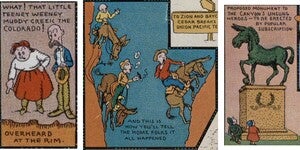Our November Map of the Month is this illustrated map titled “Grand Canyon” by Uruguayan-American artist Jo Mora. The map depicts approximately one fourth of the Grand Canyon, focusing on the portion most frequented by tourists. It features a variety of insets and illustrations highlighting the main tourist attractions in the Canyon, narrating Indigenous culture and ties to the area, and poking fun at the tour opportunities available to visitors as well as the visitors themselves.

Although the Grand Canyon was first explored by a Spanish conquistador in 1540 (Native tribes living there for hundreds of years previously aside), it would go mostly undisturbed until 1857 when Joseph Ives made his famous trip up the Colorado River. The Grand Canyon would steadily be brought back into the public eye, culminating in1919 when it became a National Park. Nowadays, it is one of the most famous and visited tourist attractions in the country.
Originally settled by miners and trappers, the towns near the Canyon’s rim quickly turned to tourism when they discovered the wealth it could generate and focused on developing tourist accommodations to make the tricky terrain easier to navigate. By the time this map was created in the 1930s, there were over 45,000 visitors to the Grand Canyon each year and the number was quickly rising. This map’s creator, Jo Mora, was a multi-talented artist regarded as “The Renaissance Man of the West” whose most popular works included his maps of American landmarks and cultures, all of which featured the same rich illustration as seen on this map.
One of the most prominent tourist attractions highlighted on this map is the Phantom Ranch (named after the nearby Phantom Creek and Phantom Canyon), a collection of cabins and dormitories at the bottom of the canyon available for visitors to stay overnight. The area’s prime location led it to be frequented by multiple Native American populations as early as 4000 years ago and when European American explorers came across it, they began using it as a campsite and eventually went on to build a more permanent settlement. Phantom Ranch opened in November of 1922 and was quickly expanded to include more cabins, a dining hall, and other accommodations in response to the large number of visitors interested in staying there. The rustic conditions of the camp (described in above right image) intrigued tourists in the 1930s and continue to intrigue them in the present, albeit with a few more modern additions.
This map also includes depictions of Native American art and culture of the Southwest. There are depictions of several gods from Hopi mythology as well as an insert that tells the Hopi creation story in which the first Hopi were created below the earth and led to the surface through the Grand Canyon. There are also references to the abandoned cliff dwellings that are located throughout the Grand Canyon. Finally, there are panels like those pictured above depicting members of the Hopi and Navajo communities and encouraging tourists to buy the crafts made by these communities.
In addition to the more serious notes and explanations on this map, Mora included a number of humorous insets, most of which poke fun at tourists and their habits while visiting the Grand Canyon. As the Canyon grew more popular every year, inexperienced and unprepared visitors made up most of the tourist population, leading tour guides to implement the ever-infamous mule rides to the bottom and other similar methods. These methods were especially humorous to experienced hikers who visited and even to many of the visitors themselves. As a result, cartoonish illustrations of tourists like those shown above made jokes out of their habit of underestimating the Canyon’s size as well as the prominent role of mules in their journeys into the canyon.
We hope you enjoyed this month's map! As with all of our Map of the Month features, if you’d like to learn more about this map or schedule a visit to explore our maps in person, please submit a Map and Geo Service Request. We’ll be sure to get back to you within two business days, but typically sooner.
- Kelsey Kerley, Map and GIS Assistant



